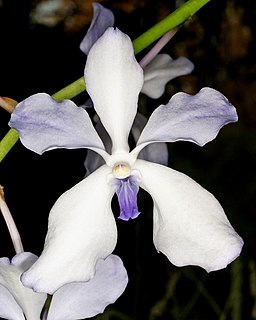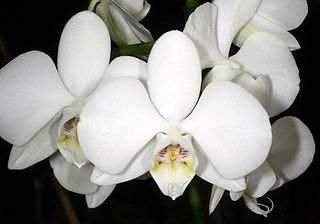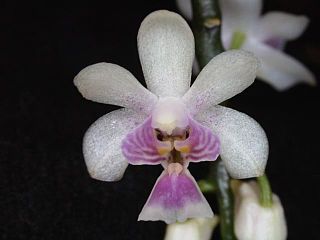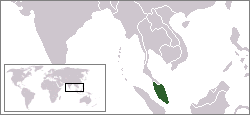
Vanda, abbreviated in the horticultural trade as V., is a genus in the orchid family, Orchidaceae. There are about 87 species, and the genus is commonly cultivated for the marketplace. This genus and its allies are considered to be among the most specifically adapted of all orchids within the Orchidaceae. The genus is highly prized in horticulture for its showy, fragrant, long-lasting, and intensely colorful flowers. Vanda species are widespread across East Asia, Southeast Asia, and New Guinea, with a few species extending into Queensland and some of the islands of the western Pacific.

Phalaenopsis, also known as moth orchids, is a genus of about seventy species of plants in the family Orchidaceae. Orchids in this genus are monopodial epiphytes or lithophytes with long, coarse roots, short, leafy stems and long-lasting, flat flowers arranged in a flowering stem that often branches near the end. Orchids in this genus are native to India, Taiwan, China, Southeast Asia, New Guinea and Australia with the majority in Indonesia and the Philippines.
Johannes Jacobus Smith was a Dutch botanist who, between years 1905 to 1924, crossed the islands of the Dutch East Indies, collecting specimens of plants and describing and cataloguing the flora of these islands. The standard botanical author abbreviation J.J.Sm. is applied to plants described by J.J. Smith.

The Bogor Botanical Gardens is a botanical garden located in Bogor, Indonesia, 60 km south of central Jakarta. It is currently operated by Indonesian Institute of Sciences. The Garden is located in the city center and adjoin the presidential palace compound of Istana Bogor. It covers an area of 87 hectares and contains 13,983 different kinds of trees and plants of various origin. The geographic position of Bogor means it rains almost daily, even in the dry season. This makes the Garden an advantageous location for the cultivation of tropical plants.

Johannes Elias Teijsmann was a biologist, botanist and plant collector. He was born in Arnhem, The Netherlands. His surname is sometimes spelled Teysmann, although he himself spelled it Teijsmann.

Phalaenopsis stobartiana, also known as 滇西蝴蝶兰 in Chinese, is a species of epiphytic plant in the family Orchidaceae. It is endemic to Hainan, China. The specific epithet stobartiana refers to Willliam Culley Stobart. The Stobart family were the principal landowners and colliery owners in the 19th century in England.

Phalaenopsis amabilis, commonly known as the moon orchid or moth orchid in India and as anggrek bulan in Indonesia, is a species of flowering plant in the orchid family Orchidaceae. It is native to the East Indies and Australia, and widely cultivated as a decorative houseplant. It is an epiphytic or lithophytic herb with long, thick roots, between two and eight thick, fleshy leaves with their bases hiding the stem and nearly flat, white, long-lasting flowers on a branching flowering stem with up to ten flowers on each branch.

Cibodas Botanical Garden is a 84.99 hectares botanical garden on the slopes of Mount Gede, located in the Cibodas subdistrict of West Java, Indonesia. It is operated by the Indonesian Institute of Sciences (LIPI).

Dendrobium bigibbum, commonly known as the Cooktown orchid or mauve butterfly orchid, is an epiphytic or lithophytic orchid in the family Orchidaceae. It has cylindrical pseudobulbs, each with between three and five green or purplish leaves and arching flowering stems with up to twenty, usually lilac-purple flowers. It occurs in tropical North Queensland, Australia and New Guinea.

Phalaenopsis bellina is an orchid endemic to Borneo. It is one of 75 species of Phalaenopsis and one of the most commonly cultivated species in the genus.

Phalaenopsis deliciosa is a species of orchid occurring from the Indian subcontinent to Malesia and China. The species is a miniature epiphytic herb. The leaves are unique due to their undulate margins. This characteristic greatly simplifies the identification of the species, even when specimens are not currently flowering. The small flowers are usually slightly pink, but white and yellow forms exist as well. Old inflorescences, which are usually panicles or more rarely racemes, may continue to grow and form new flowers over several flowering periods.

Phalaenopsis gigantea is a species of orchid endemic to the island of Borneo and was first described in 1909. The specific epithet gigantea refers to the giant size of its leaves, which can grown over 60 cm in length on a mature plant. It is the largest known Phalaenopsis species.

Phalaenopsis tetraspis is a species of epiphytic orchid endemic to the Andaman Islands, the Nicobar Islands and northwestern Sumatra. It was originally erroneously published as a Himalayan species by Reichenbach, which was corrected by James Veitch 23 years after Heinrich Gustav Reichenbachs publication. Mature specimens may have up to nine leaves, but usually plants have 4–5, elliptic-obovate, acute to obtuse, 20 cm long and 8 cm wide leaves. Showy, fleshy, fragrant flowers are produced on axillary, arching to subpendent racemes or panicles. A prominent feature of this species is the midlobe of the labellum, which is oblong, obtuse-subacute, and the apex is covered in dense trichomes. The karyotype is asymmetric and nonuniform.

Phalaenopsis × intermedia, the intermediate phalaenopsis, is a natural occurring hybrid of epiphytic orchid endemic and most commonly seen orchid species in the Philippines. A progeny of Phalaenopsis aphrodite and P. equestris, this orchid thrives in the heat of the lowlands, in primary and secondary forests at an altitude of sea level to 300 meters where it blooms all year round. Unlike other natural hybrid within the genus, P. × intermedia is seldom found growing within the range of its parent species and has formed sexually reproducing, stable populations in the wild. All red-lipped Phalaenopsis have pedigrees that can be traced back to this orchid.

Phalaenopsis javanica is a species of orchid native to Java and Sumatra. The specific epithet javanica refers to the Indonesian island Java.

Phalaenopsis mentawaiensis is a species of orchid endemic to Sumatra, Indonesia. The specific epithet mentawaiensis refers to the Mentawai islands of West Sumatra.

Phalaenopsis modesta is a species of orchid endemic to Borneo. The specific epithet modesta, from the Latin modestus, means unassuming, moderate or modest.

Phalaenopsis × valentinii is a species of orchid native to peninsular Malaysia. It is a natural hybrid of Phalaenopsis violacea and Phalaenopsis cornu-cervi.

Phalaenopsis × singuliflora is a species of orchid native to Borneo. It is a natural hybrid of Phalaenopsis bellina and Phalaenopsis sumatrana. Its name singuliflora is derived from the consecutively produced flowers.

Phalaenopsis × gersenii is a species of orchid native to Borneo and Sumatra. It is a natural hybrid of Phalaenopsis violacea and Phalaenopsis sumatrana. It is named after Gerrit Jan Gersen (1826-1877). He was a Dutch official, who was deployed to the Dutch East Indies, where he also was active as a plant collector of the Malesian region.



















